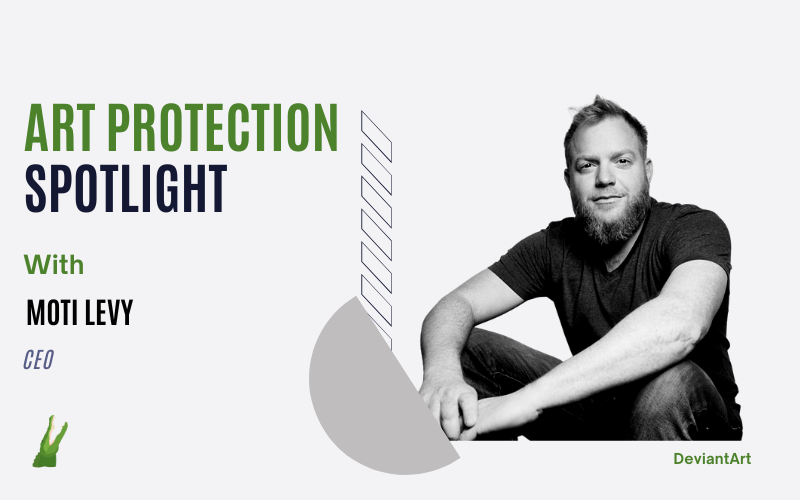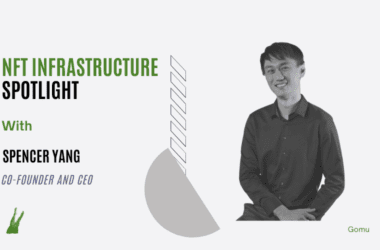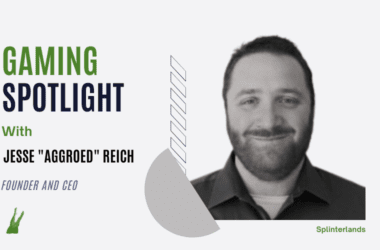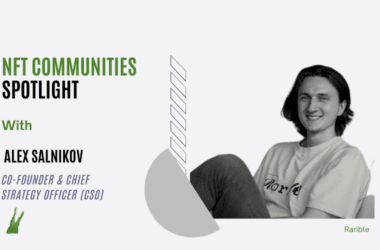For those who’ve been on the Internet since the early 2000s, DeviantArt would be a familiar name. Founded in August 2000, DeviantArt is the first platform that provided the tools and products for creators to display their art, collaborate and communicate with each other.
The platform is a community for visual artists, some of whom honed their skills and started their art careers through the website. Over the last two decades, DeviantArt has continued evolving with its community, publishing tools for curation, collection, and monetisation, allowing visitors to purchase pieces of art from the platform.
Today, DeviantArt has more than 70 million registered users and half a billion pieces of art submitted and 100 million visitors. In recent months, DeviantArt made its foray into Web3 by extending its art and NFT image protection software to all Web3 creators. It also launched its own API, named Protect Protocol, that detects NFT copies across multiple blockchains and marketplaces.
Following the release of the Protect Protocol at NFT NYC which took place last week, we speak to DeviantArt CEO Moti Levy to find out more about the motivation behind the company’s movements in Web3.
Please tell us about yourself and the story behind your role at DeviantArt.
Back in 2017, Deviantart was acquired by Wix and with that acquisition, I was asked to join as COO to help lead the company’s business, expansion, and transformation. I was doing that up until this April, when the co-founder and CEO for the last 22 years decided to step aside and I assumed the role of CEO. I’ve been with the company for 5.5 years.
Congrats on your new role.
As the COO of Deviantart, I’m doing everything so there are some aspects that are new but most of it was very natural to step in. I’m surrounded by an insanely talented management team and an insanely talented team overall from designers to community support. I’m fortunate to work with those people.
What piqued your interest in the NFT space and where did you first hear about it?
It’s not about me personally but about Deviantart. Devianart has evolved with the creator community and we’re developing tools catering to their needs. Web3 and NFTs bring a lot of promise and hope to creators. The ability to register their work on the blockchain that’s permissionless and trusted, remove the middleman and create a new equity class for them, meaning that they can take their work and monetize without any proxies and they can control who’s going to buy it, price and what happens after the initial sale, and guarantee proceeds from their creation for eternity is something that we find very interesting and compelling for the creator community.
This is the evolution and there is no question that we need to be part of it. We’ve been monitoring the NFT space for quite some time but honestly at the beginning of 2021 when it became very hot, we decided to add more value and opportunities—what needs to be done and how DeviantArt can play a role, but we started from a completely different angle.
Why didn’t DeviantArt start out as an NFT marketplace but instead with the image protection software and the Protect Protocol?
We have most likely the most engaged creator community in the world. Many investors and partners have asked us why we’re not launching an NFT marketplace. Many marketplaces have started to pop up, enabling creators to make money out of it, but what we’re doing always must have value to our community. When we reviewed the needs of the community back then and how it’s going to evolve, a marketplace wasn’t one of the things our community needed. Yes, we could’ve done it, but obviously, the real problems our community and other creators in the space started to have been around the protection of content right.
The issue of art infringement isn’t something new. It goes back 2500 years ago with imitation of art and with digital art we’ve seen in the last 20 years, it happened in Web2. As a company dealing with art infringement for the last 20 years, we knew it was going to happen in a much more rapid way. So what we decided to do is to put protection to provide value to our creators against art infringement in the NFT world. This is something we launched back in Aug-Sep but we worked on the technology of deep machine learning and image recognition for the last 6-7 years.
We’ve been using this technology for personalisation experience. If you like fan art and someone else likes photography, I want to make sure that you’re getting a personalised experience. We’ve continued to develop this technology for the last two years and we’ve decided to take it and adapt the technology against resharing and reposting of art on DeviantArt to fight some art infringement on our platform.
Despite not being an NFT platform, why did DeviantArt extend its art and image protection solutions to the NFT space?
When we started to see NFT spike, we already knew about a major problem even before the space understood it. And we decided to launch and work on the Protect Protocol to help and provide value to our community and instil a sense of safety and trust in our community with NFTs and web3. So first of all you’re protected, and if you decide to mint your pieces, we’re still gonna make sure others are not going to take your minted piece and continue minting it.
There are several marketplaces. Any artist can decide to mint and NFT. Yes we can do it but we didn’t see any single marketplace, neither Web2 nor Web3, that puts safe and trust and fights against art infringement on their platform.
DeviantArt Protect and the Protect Protocol detect NFT copies across multiple chains, but will users be able to see which NFT platforms/marketplaces the copies appear on?
The main challenge was to start scanning blockchains. We’re scanning 9 different blockchains, both Ethereum and non-Ethereum non-EVM blockchains. We scan more than 12 million newly minted NFTs every week. Up until today, there were 329,000 infringements that we’ve found since we launched Protect and to us, that was the real value in the NFT world that our users needed even before they understood it. It was the key for us because that’s what we’re doing with the creator community.
Three months ago, we decided to offer protection for non-Deviantart users. Our commitment is not just to DeviantArt users but to the creator community at large. Last month, we launched a service where any creator can come and drop their images into a folder and if we find infringement, we will send the artist alert and we will help them to take it down from the platform where we found the infringement.
We decided to take it one step further and release the Protect Protocol, an API, which was released last week at NFT NYC. What if we create a collaboration with other platforms and we open the infringement for anyone to see the original piece, the infringed piece and where the item is being listed? Today we’re putting pressure on different marketplaces and it’s clear on which platforms the infringements still happen and which ones took them down. For you as a buyer, let’s say you want to buy a piece of art from one of those marketplaces, you can take the address of the NFT and search it on our database and we can tell you if we found an infringement or not.
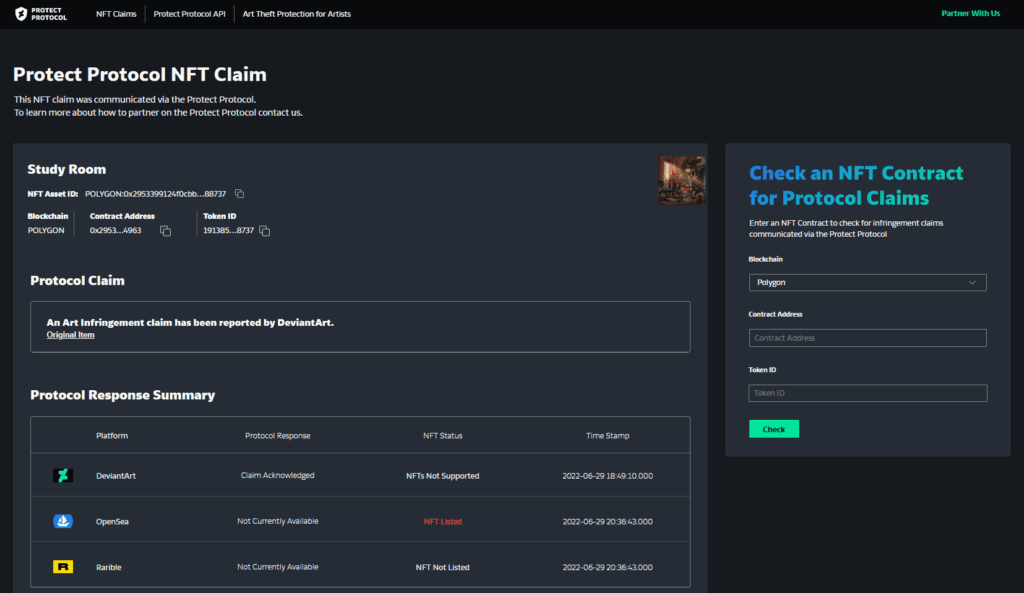

What’s the business model of Protect Protocol? Is it a paid service? If not, why, and will it be a paid service in the future?
Right now it’s completely free. Anyone can use it whether they’re partners or not. The protocol is our attempt to collaborate with other partners so we provide the API and ask all the big players in the market, whether Web2 or Web3, to join us and make sure that Web3 is safe for creators.
A number NFT fraud detection services have started popping up. How does Protect Protocol set itself apart from the others?
We’re marketplace and blockchain gnostic. We’re not just finding two similar images. We hold a registry of half a billion pieces, we have the context of those images. If we find a match and we see an image that was submitted in 2014, we know who’s the artist, when they submitted it and how many collections and curations they’re part of. Image recognition today is not rocket science. We have the user base and we’re coming with zero interest in manipulating the market.
We have this registry of images, we can compare against it, we’re adding more and more DeviantArt images so we can say with a level of certainty: “This image was submitted in 2008, this NFT was minted yesterday. What are the chances that the person who minted yesterday was really the owner?” If the person that submitted in 2008 said “no this is my piece,” there’s a good chance that the person that minted yesterday was not the real owner. The person who submitted in 2008 to DeviantArt who has a collection, submissions and is a real artist, we have a way to provide evidence of Web3 infringement.
It took OpenSea quite some time until they launched their service two months ago. Kudos to them, they’re the only NFT marketplace doing that right now for Web3. We collaborated with OpenSea and helped them understand the problem. We have a good relationship with them.
Back in August when everything was amazing and nobody wanted to hear about art infringement, we were the first company screaming about how harmful it is that there is no art protection for the creators, how big the phenomenon of art infringement is, and it took some time for the industry to recognise that and start to develop solutions that will copy DeviantArt’s solution to some extent. We’re happy, this is great, it’s a blessing that those companies now recognise it.
What other blockchains will be added to Protect Protocol in the future and when?
Yes, we are. A very big portion of the DeviantArt team is working on things that pertain to Web3, around the Protect Protocol and more to provide creators with what they need in terms of tools and products. Adding a blockchain is just one thing in our roadmap. I think the idea of a marketplace is always there but we need to make sure that it’s what our creators need and to provide a safe marketplace. Right now, there is no plan of doing that because the time isn’t right. We don’t want to play in the Wild West.
How else will DeviantArt/Protect Protocol expand its reach in the NFT space?
I was at NFT NYC last week and also last year. The last NFT NYC was very different from this year’s, not because of the cooldown in the market, but because the conversation changed.
Last year when we were shouting about protection, people looked at us like lunatics. Creators will not adopt NFT and Web3 until we provide platforms that provide them with all their needs, not just money.
This year, we participated in three different panels that were around scanning, and protection of NFTs and art, with OpenSea and Coinbase participating as well. Big Web2 and Web3 companies are talking about putting checks and balances, and fighting art infringement. Companies with the same solution are popping up—this is amazing. It’s not just DeviantArt that needs to be the one carrying the flag to fight art theft. It’s supposed to be cross-collaboration between companies. This is how we plan to scale. DeviantArt wants to be part of the pack alongside big companies to create those checks and balances.
What are the most challenging aspects of your role at DeviantArt and how do you overcome these challenges?
I’m working with a team that is beyond amazing, that’s how I overcome any challenges. The challenge is what is the right strategy, the vision for DeviantArt moving forward and how we are building the right roadmap that will not just cater to the needs of existing users but to future users. How can we balance what they want with what they still don’t know but will need, because we have a unique vantage point of seeing where the industry goes and putting resources into things that don’t make sense right now but will make sense in future.
DeviantArt is not going to be a Web3 company, it’s a company for creators. We’ve built things that will serve whatever evolution we’ll see on the web. We’re adding layers that are relevant for Web3 but we’re not going to forget where we came from and the tools that continue to be relevant no matter the number you put next to the word, ‘web’. At the end of the day, people want to connect, collaborate and get feedback, especially creators. That will never change. This is what we’ve done for two decades and what we’re planning to do for the next two.
What do you think about the current state of the NFT market?
Obviously, there is a decrease in the floor price of an NFT so that’s pretty natural but this is a blessing because now that this hype is reduced, we can focus on the infrastructure. That’s a “tech debt”. There are many things we need to go back and fix and this is the time to fix those problems. Art infringement and counterfeiting are things we care a lot about so you’ll see more solutions coming from us this year.
Where do you think we could see NFTs in the near future?
We’ll see more adoption overall. I see a lot of talents in tech, finance, legal and regulations because they see huge opportunities to make an impact. Usually, when talented and creative people come to a new space, they bring solutions and are inventing things we can’t even see right now. I think we’ll see more innovation and more collaboration around the problems that Web3 brings with it. We’ll see regulators stepping in, providing guidance. We’ll see institutions from big corporates to entertainment companies making more investments in Web3 and NFT.
Stay up to date:
